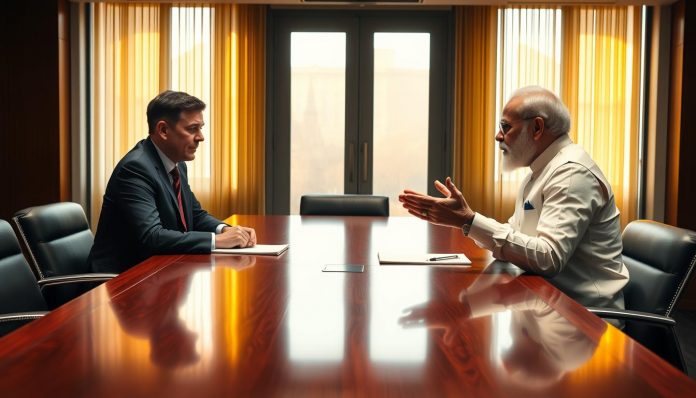In October 2025, a landmark meeting in Mumbai signaled a powerful new chapter in international relations. The British prime minister, Keir Starmer, met his counterpart, Narendra Modi, to build upon a historic pact signed just months earlier.
This gathering was far from a standard diplomatic visit. Starmer led the UK’s largest-ever trade delegation, a clear statement of intent. The delegation’s size underscored the agreement’s potential scale.
At a joint press conference, the British leader described the pact as a “launchpad” for future prosperity. He emphasised its ambition, calling it a transformative moment for both nations and a significant step in strengthening UK-India relations. The ceremonial welcome in India’s financial capital, with images of both leaders displayed across the city, highlighted the partnership’s importance.
This trade deal aims to boost cooperation in technology, life sciences, and renewable energy. It represents a strategic alignment between two major democracies, seeking stability and growth in an uncertain global landscape.
Key Takeaways
- The meeting between the British and Indian prime ministers in Mumbai was a significant diplomatic event.
- Keir Starmer led the largest trade delegation in UK history for the visit.
- The new agreement was characterised as a “launchpad” for enhanced economic cooperation.
- The deal is seen as highly ambitious, with potential benefits across multiple sectors.
- The partnership is framed as a source of stability in global affairs.
- The ceremonial welcome demonstrated the importance both nations place on the relationship.
Context and Significance of the UK-India Trade Deal
Current economic exchanges between the two democracies demonstrate a remarkable transformation from historical ties to contemporary cooperation. The bilateral relationship supports over 600,000 jobs across both nations through approximately $56 billion in annual commerce.
Overview of Bilateral Trade and Economic Ties
India’s economic ascent positions it as a crucial partner. The nation became the world’s fifth-largest economy in 2022. Projections indicate it will reach third place by 2028.
Britain, as the sixth-largest global economy, finds strategic value in deepening these economic connections. The new agreement represents a forward-looking partnership beyond traditional historical links.
Since its signing in July, the pact has already generated £6 billion in trade and investment. This includes £1 billion of investment creating nearly 7,000 British jobs within three months.
Role of Keir Starmer and Narendra Modi
Both prime ministers demonstrated significant political leadership in finalising this comprehensive agreement. Their predecessors had struggled to reach such a deal despite previous attempts.
The British leader’s commitment was evident through leading the largest-ever trade delegation. This included over 100 senior business figures traveling to Mumbai.
His counterpart has actively positioned the country as a manufacturing and services hub. This alignment creates mutual benefits for both economies and businesses.
The personal rapport between the two leaders contributed to the agreement’s success. Their shared vision focuses on doubling current trade volumes ahead of schedule.
For the original reporting and full context, read the BBC article on the Starmer-Modi meeting.
Starmer Hails India Trade Deal as ‘Launchpad’ with Modi
The ‘launchpad’ metaphor employed by the British leader reflects the agreement’s forward-looking nature and expansion potential. It characterises the pact not as a final destination but as a foundation for exponential growth across multiple sectors.
Key Features of the Free Trade Agreement
Specific tariff reductions form the core of this comprehensive arrangement. The UK will cut taxes on imported clothing, footwear, jewelry, and frozen seafood.
India reciprocates with duty reductions on British exports, including Scotch whisky, cosmetics, medical devices, and luxury cars. These measures benefit consumers and businesses in both nations.
| UK Tariff Reductions | Indian Tariff Reductions | Expected Impact |
|---|---|---|
| Clothing & Footwear | Scotch Whisky | Lower consumer prices |
| Jewellery | Cosmetics | Increased market access |
| Frozen Seafood | Medical Devices | Competitive advantages |
| Various manufactured goods | Luxury Cars | Sector growth |

Even before full implementation, the deal has generated significant economic benefits. The UK government reports £1 billion of investment creating nearly 7,000 jobs.
Strategic Implications for Global Trade
This agreement positions both nations strategically amid changing international dynamics. It demonstrates how major economies can forge new partnerships in a shifting global landscape.
“This is just the start. It’s time to invest in the United Kingdom, invest in this relationship and invest in our shared future.”
The leaders also addressed sensitive geopolitical issues during their discussions. Differences on energy security and international conflict were acknowledged while maintaining focus on economic cooperation.
Implementation is expected within a year, giving businesses time to prepare for new opportunities. The pact represents a pragmatic approach to diplomacy that balances economic interests with strategic considerations.
Economic Opportunities and Emerging Sectors
British universities are expanding their global footprint with new campuses that strengthen bilateral educational cooperation. The University of Lancaster and the University of Surrey received approval for new campuses, joining several other institutions planning openings next year.

Growth in Digital Services and Green Energy
The relationship extends beyond traditional sectors into cutting-edge fields. A joint center for artificial intelligence and a connectivity innovation center demonstrate a commitment to technology collaboration.
Green energy receives significant focus through a critical minerals industry guild. This initiative bolsters supply chains while promoting sustainable technologies.
Digital transformation features prominently in the partnership. The British leader’s meeting with the founder of India’s digital ID system aligns with UK government plans for worker identification.
To explore this critical question in depth, read our full article here: “Can Trade Survive the Age of Tariffs, Sanctions, and Populism?”
Technology Transfer and Investment Prospects
Educational expansion brings substantial economic benefits. The university campuses initiative contributes £50 million to the British economy while creating revenue streams.
Direct investment commitments show strong business confidence. Sixty-four companies pledged £1.3 billion across various sectors in the UK.
Defense cooperation represents another growth area. Contracts include £350 million for missiles and £250 million for electric naval engines.
| Sector | Investment Value | Job Creation Impact |
|---|---|---|
| Higher Education | £50 million | Academic and support roles |
| Corporate Investment | £1.3 billion | Multiple sectors |
| Defence Technology | £600 million | Manufacturing and engineering |
| Green Energy | Industry guild established | Supply chain development |
The diversified nature of this cooperation creates resilient employment growth. Business forums during the visit facilitated direct partnerships between companies from both nations.
Conclusion: Starmer Hails India Trade Deal as ‘Launchpad’ with Modi
Looking beyond the immediate economic figures, this partnership signifies a profound strategic alignment. The British prime minister characterised the deal as a beginning, not an end. Its early impact, with billions in new trade and thousands of jobs created, proves its potential.
Projections point to massive growth in the coming years. This strengthens both nations’ economies and offers a stable partnership in an uncertain world. As one leader noted, it sets an example for other countries.
The cooperation extends far beyond traditional sectors into technology and green energy. This gives British businesses a unique edge in a major growth market. The full implementation of this historic UK-India trade pact over the next year will unlock further opportunities, solidifying a transformative relationship for the future.


